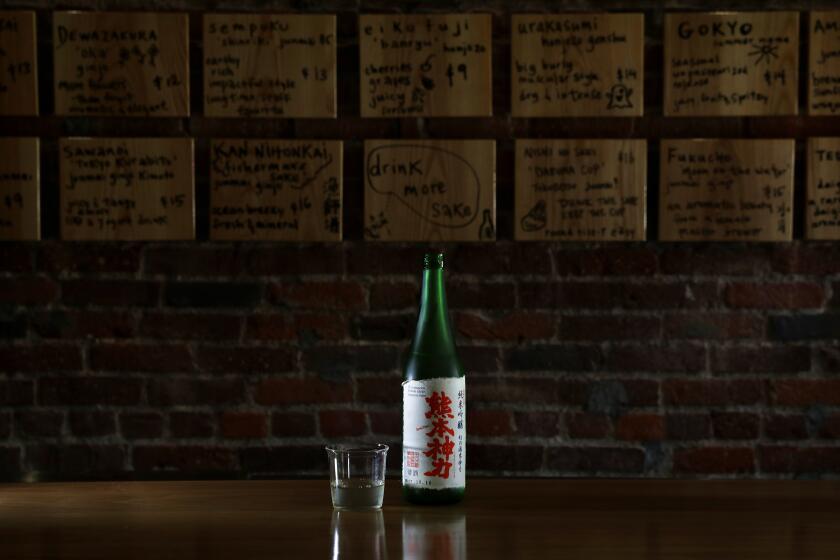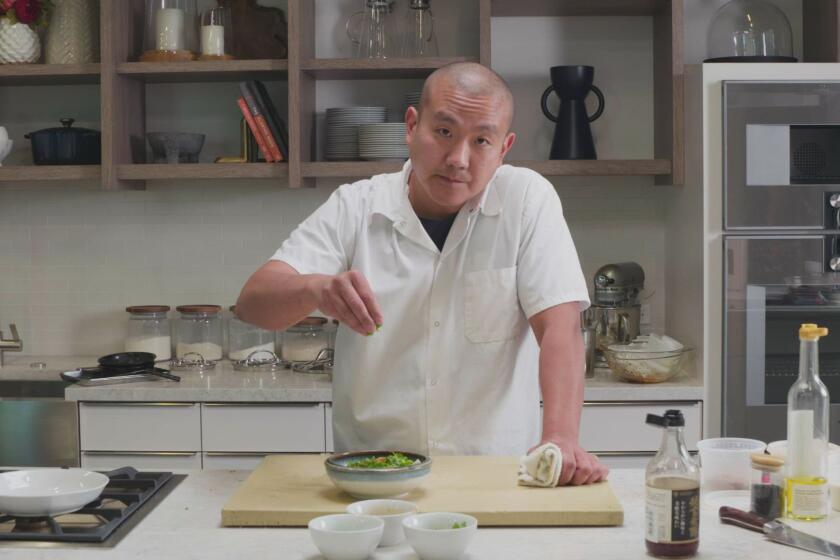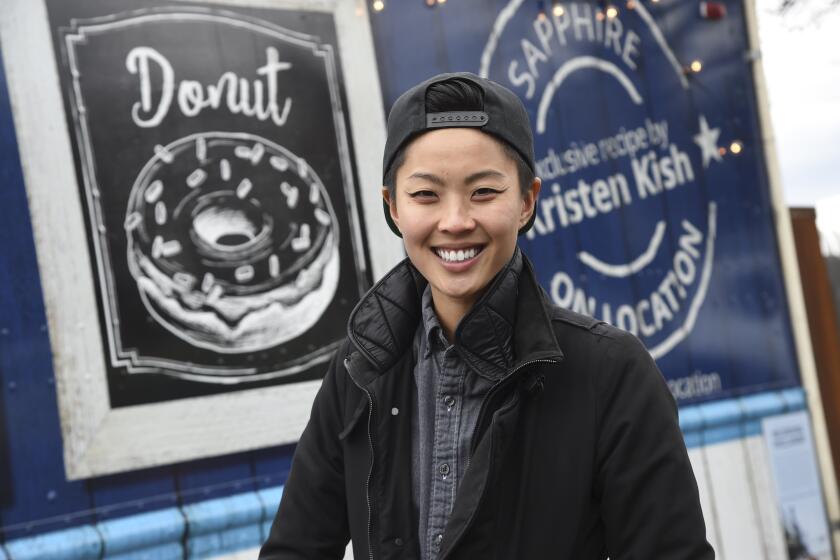How the Tsubaki team is blending French with Japanese at downtown’s newest bistro

- Share via
Two James Beard Award-winning restaurateurs have opened a bistro they’d long dreamed of, combining French and Japanese flavors at Camélia in the Arts District in downtown Los Angeles. The new restaurant is the latest project from Charles Namba and Courtney Kaplan, who also operate L.A. Times 101 List awardee Tsubaki and Ototo in Echo Park. Camélia takes over a storied space at the base of the Biscuit Company Lofts.
“Chefs have just been doing this combination of cuisine for a very long time,” Namba said. “I’ve worked in Japanese kitchens, I’ve worked at French kitchens, and I grew up eating a lot of food that was French-Japanese — or Italian-Japanese — and it’s kind of my interpretation of the two cuisines.”

French and Japanese cooking tend to lend themselves particularly well to each other, Kaplan added. Koji-roasted chicken is laid atop seaweed cream sauce; tomatoes marinate in kombu dashi before they’re plated with burrata and shiso; and the spaghetti Bolognese à la Japonaise, a riff on Namba’s childhood spaghetti, is deep with tomato umami in an ode to the oft-added ingredient of ketchup in Japanese spaghetti.
“There’s a lot of harmony between the two cuisines,” Kaplan said. “We’ve spent some time in Paris and when you go to restaurants, so many of the modern bistronomie restaurants in Paris are run by Japanese chefs, and you see Japanese flavors, and then you go to Tokyo and eat at beautiful French restaurants there. It just seemed like a really natural fit to harmonize the two together, and it also really reflected both of our professional and personal backgrounds.”
Namba and Kaplan, who met while both were working at Japanese brasserie En in New York City, had always imagined they would open a French restaurant. During the pandemic, with their restaurant and their sake bar shuttered, they began to question what could be next for them — both in seriousness and as a lark.
Here’s everything you ever wanted to know about sake, plus what to buy and where to find it.
“I thought it was pretty likely that Tsubaki and Ototo would not survive the pandemic,” Kaplan said. “It was sort of like, ‘Oh, I’ll probably never open a restaurant ever again,’ but there was something fun about fantasizing, like, ‘Oh, if we ever were to do this again, what would we want to do?’ [We had] a bunch of ideas, but kept coming back to this idea of a French-Japanese restaurant.”
When they learned the former home of Church & State and Caboco was available, they were daunted by its size, larger than their Echo Park spaces, but emboldened by its history. They set about installing warm oak accents and a marble bar in the industrial space. There are roughly 120 seats spread across the dining room, the patio, the eight-seat bar and a cozy four-seat low counter near the kitchen.
They also added a menu nod to its days as Church & State: The popular abalone-and-mussels pot pie is a riff on a dish from République originally by former Church & State chef Walter Manzke.
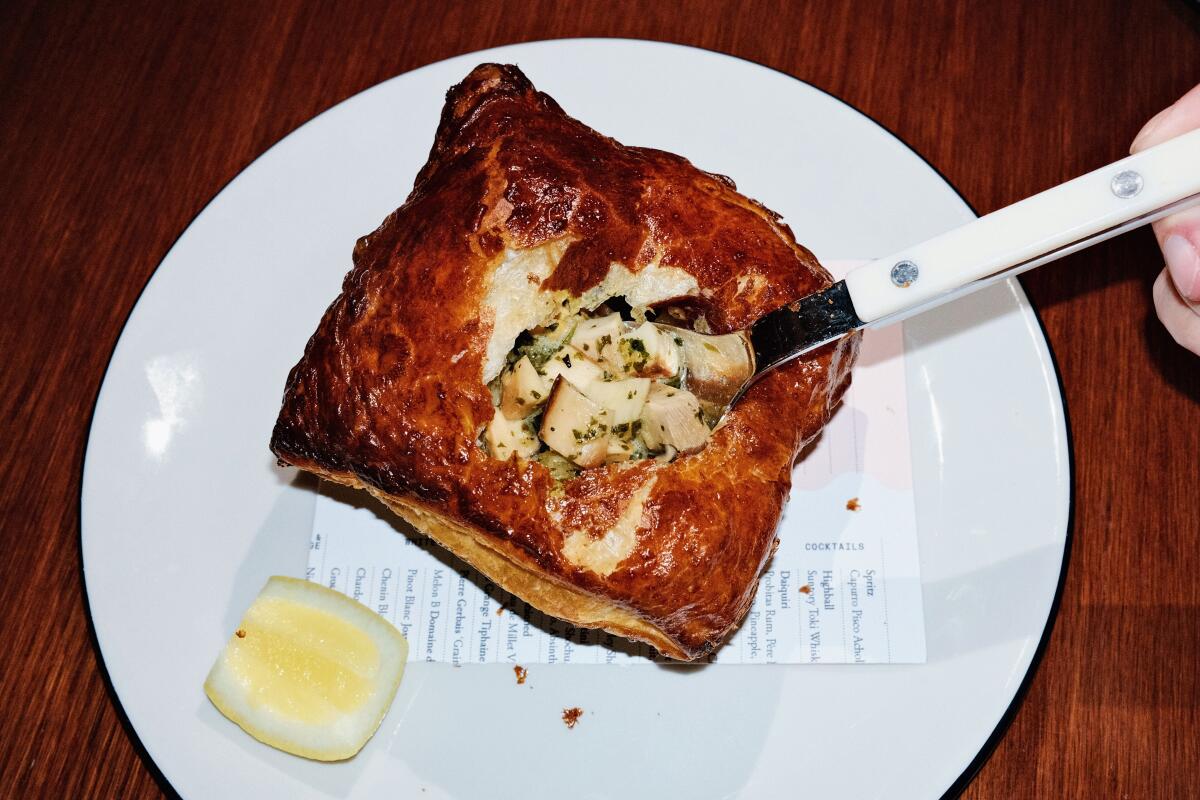
Nearly all produce is sourced from the farmers market, such as the daily-rotating aioli garni, which improves on classic crudités with some vegetables served fried or pickled in addition to raw. Seafood is sourced locally as well as from Japan. On the menu are otoro-and-tuna tartare, oysters with ponzu mignonette, spot prawn sashimi, scallop-and-prawn bouillabaisse and striped bass with ikura and a yuzu kosho butter sauce.
Nestor Silva (formerly of Rustic Canyon) is chef de cuisine, while his twin brother, Estevan Silva, is pastry chef overseeing desserts and breads; there’s milk bread in lieu of baguettes with raw-bar bites and Parker house rolls laced with black sesame. Look for Japanese flavors woven into French pastries, such as yuzu in a Chartreuse crémeaux served alongside a berry tart, or a pudding that features caramel made with kokuto, or black Okinawan sugar.
Charles Namba’s road to Tsubaki, L.A.’s beloved izakaya, and Ototo sake bar began with a dead-end pizza job, an escape from LA to NYC and a return to the food of his childhood.
Kevin Nguyen, formerly of Death & Co., developed a bar program of classic cocktails using French and Japanese spirits and flavor profiles. A Japanese whiskey highball gets a splash of French peach aperitif along with shiso; the milk punch involves shochu and matcha; and the Decibel martini, inspired by the lychee version served at a New York City bar where Kaplan worked years ago, also incorporates absinthe and umeshu. Kaplan oversees the wine and sake. Much like at Ototo, wines and sakes at Camélia are grouped not necessarily by what they’re made from but by the way they drink, the stories behind them or their regionality.
Camélia is open from 5 to 10 p.m. Sunday, Monday and Thursday and 5 to 10:30 p.m. Friday and Saturday, with plans to expand to daily service by the holiday season.
1850 Industrial St., Los Angeles, (213) 800-9750, cameliadtla.com
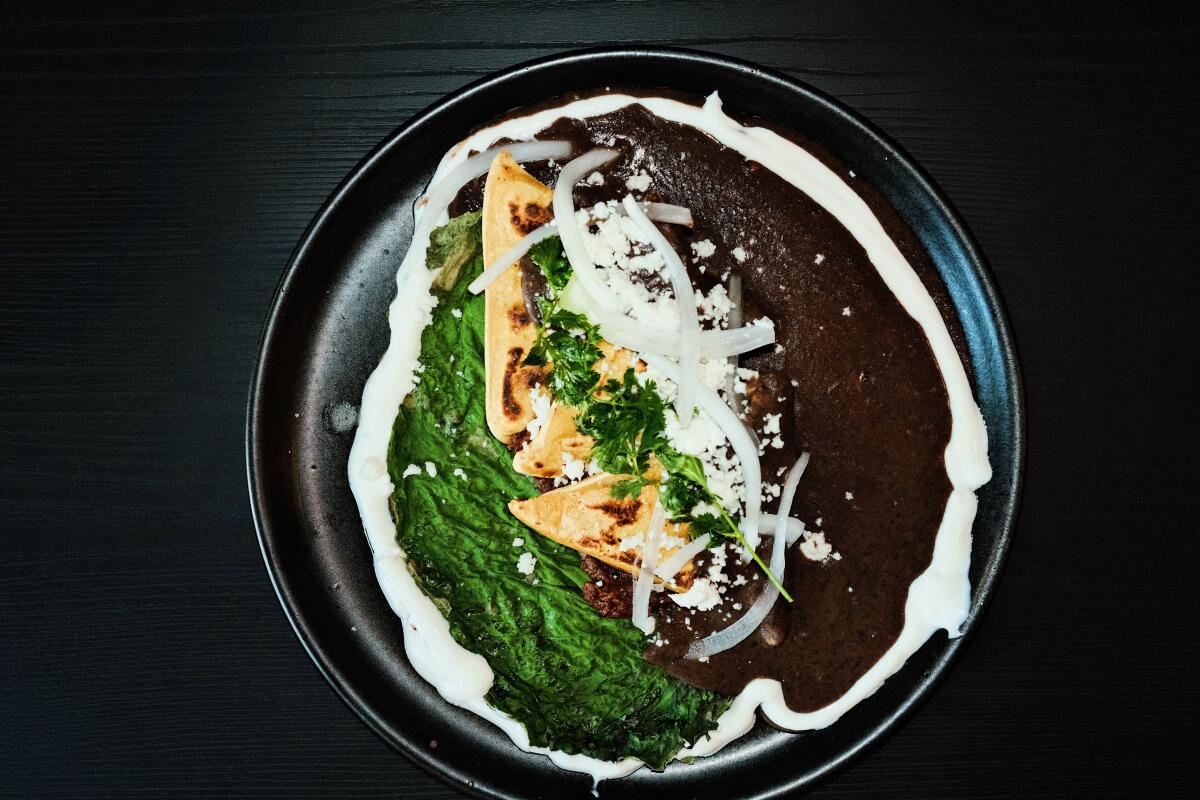
Carnal
Mariscos fans and readers of the L.A. Times 101 Best Tacos list might recognize Francisco Aguilar for his blue-tinted, wildly creative Silver Lake seafood truck Simón, but at Carnal he’s departing from his vibrant, modernist tacos and aguachiles. In his first bricks-and-mortar restaurant, all moody and painted black, Aguilar is sharing his own interpretations of the rich, bold, Oaxacan-style rancho food of his childhood.
“What I hope to create as an experience is the moment guests step foot into Carnal, that they are transporting themselves into Mexico — that they are able to leave the world behind, whatever world they’re carrying,” he said. “When they’re here, they’re able to feel like they are in Mexico from the moment they look at the food. Especially when they taste the food.”
Tetelas sit atop a pool of beans and a quasi-quesadilla made from hoja santa leaves; pork belly stews in morita sauce and arrives alongside rice and pickled nopales; thumbprinted morsels of masa called chochoyotes crown a pile of huitlacoche and mushrooms.
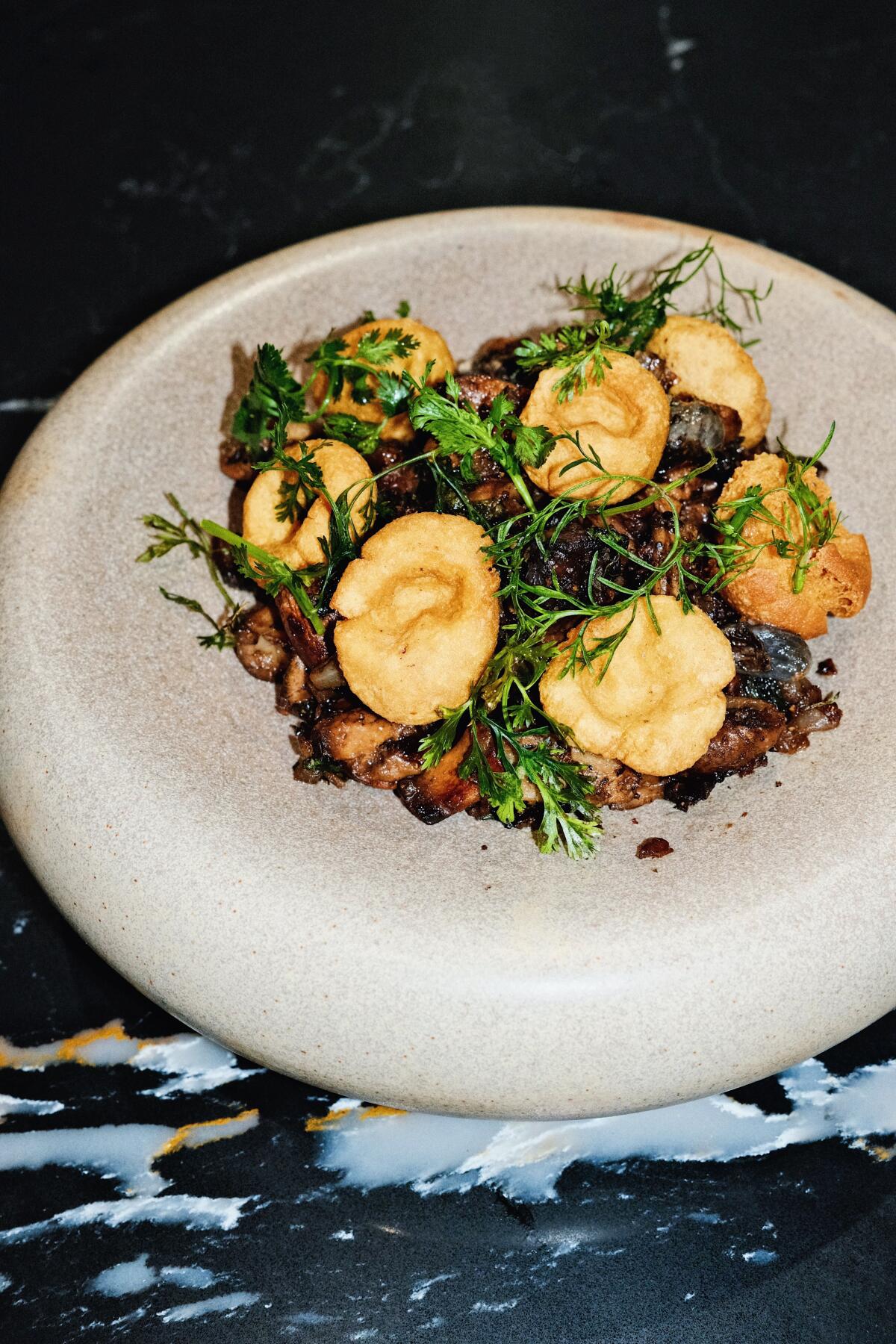
Salsas are handmade in giant molcajetes, with ingredients charred first for deep flavor. In his mole, 20 to 25 components are fried and then simmered. Tortillas of multiple colors, sizes and widths are made by hand using masa from La Gloria Tortillas in Boyle Heights. Tepache ferments for four days with cinnamon, cloves and piloncillo, while antojitos of pickled pineapple mingle with chiles and apple cider vinegar to pack a peppery punch.
The fine-dining Pitiona vet had always hoped for an opportunity to showcase the flavors of his hometown of Oaxaca City, and when restaurateurs and spouses Jaime Alvarez and Marielena Becerra — along with their business partner, Lorena Varela — tasted Aguilar’s food at Simón, they were smitten. The owners of fast-casual chain Baja Cali Fish & Tacos were planning to make changes to their Highland Park outpost, but after discovering Aguilar’s cooking, they closed their restaurant to partner in his vision.
“It was the perfect timing and the perfect moment for this to become where his flavor, his history, can come into fruition,” Becerra said.
They closed Baja Cali three weeks before Carnal’s opening, quickly flipping the space with darker tones and a more formal setting: black walls, new black marble counter seating that overlooks the open kitchen, and three dozen seats at dining tables under husks of hanging dried corn, a nod to the importance of maiz in Oaxacan cuisine and its use in nearly every dish on the menu of Carnal.
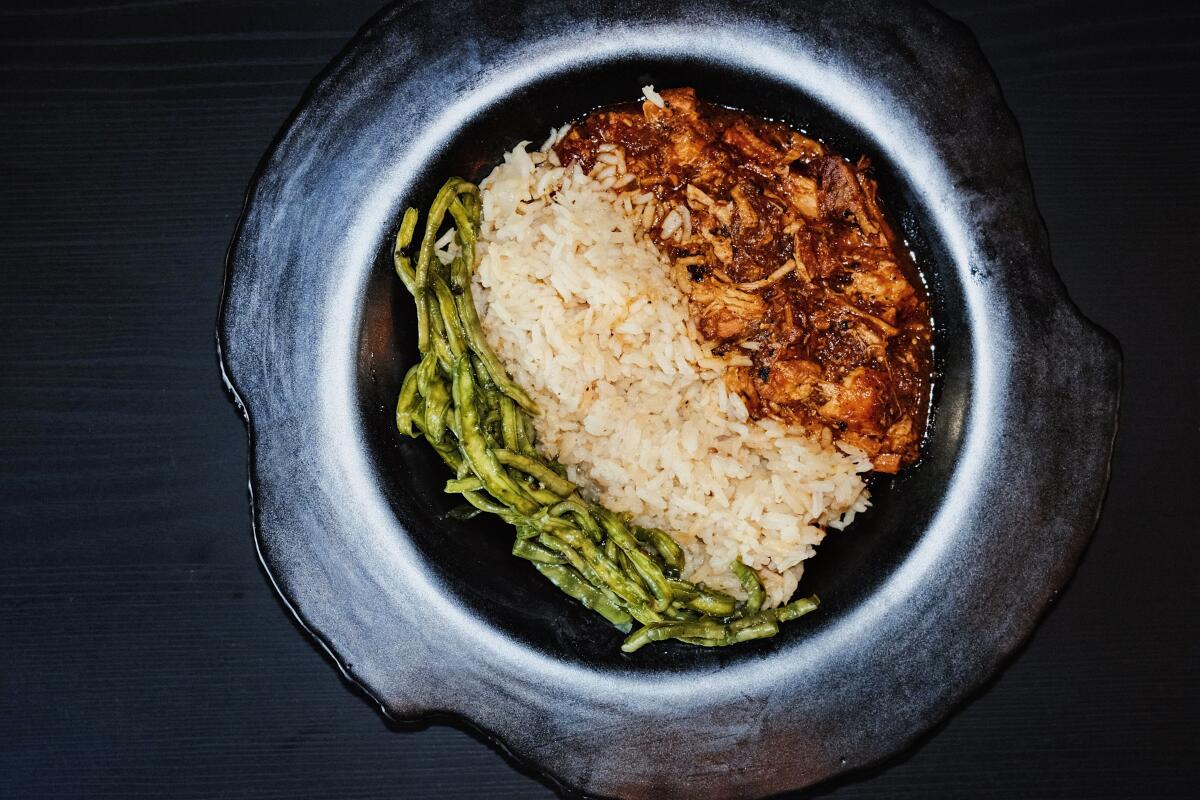
“For breakfast and the lunch, I wanted people to come and feel like they were at my home, experiencing the flavors I grew up with,” he said. “Heavy flavors.” The chilaquiles — made not with chips but tlayudas imported from Oaxaca, for a softer texture — rely on his grandmother’s recipe for the base; they can come drenched in verde sauce with two forms of lengua, or in rojo sauce with cured egg yolk.
At dinner, the menu is a place to express his “crazy ideas” and experiment, with plated options such as duck in Aztec chocolate sauce and nopal. The long tables encourage communal sharing with groups — as does Aguilar’s menu, full of personal recipes and dishes worth sampling. Carnal is open for breakfast and lunch from 10 a.m. to 3 p.m. Wednesday to Monday, and dinner from 5 to 9 p.m. Wednesday to Sunday.
5831 N. Figueroa St., Los Angeles, instagram.com/carnalfoodla
Mama’s Boy
A notable Westside chef recently took over the kitchen at bar, restaurant and music venue Winston House, adding a touch of Italian American cuisine to Venice, done his way. Wes Whitsell, formerly of Hatchet Hall, recently opened red-sauce joint Mama’s Boy inside Winston House, where he’s serving what he calls “spaghetti western” and “redneck Italian”: classic Italian American fare, made with a spin that acknowledges his Texas roots. Peaches and burrata with balsamic get a touch of country ham; arancini include pimento cheese atop a pool of hot pepper-and-tomato jelly; manicotti involves cottage cheese and venison ragù; and the cornmeal-coated fried oysters receive a side of marinara for dipping. Whitsell is now the culinary director for hospitality group Local: Los Angeles, and as such also revamped the food at sibling spot the Waterfront, which now boasts more of a Tex-Mex menu. The cocktails from beverage director Dave Purcell (also of the Waterfront, and formerly of Melrose Umbrella Co. and the NoMad) include riffs on classics such as the martini, the mai tai, the whiskey sour, the espresso martini, the Garibaldi and more. Mama’s Boy is open at Winston House from 6 to 11 p.m. Tuesday to Saturday.
23 Windward Ave., Venice, mamasboyitalian.com
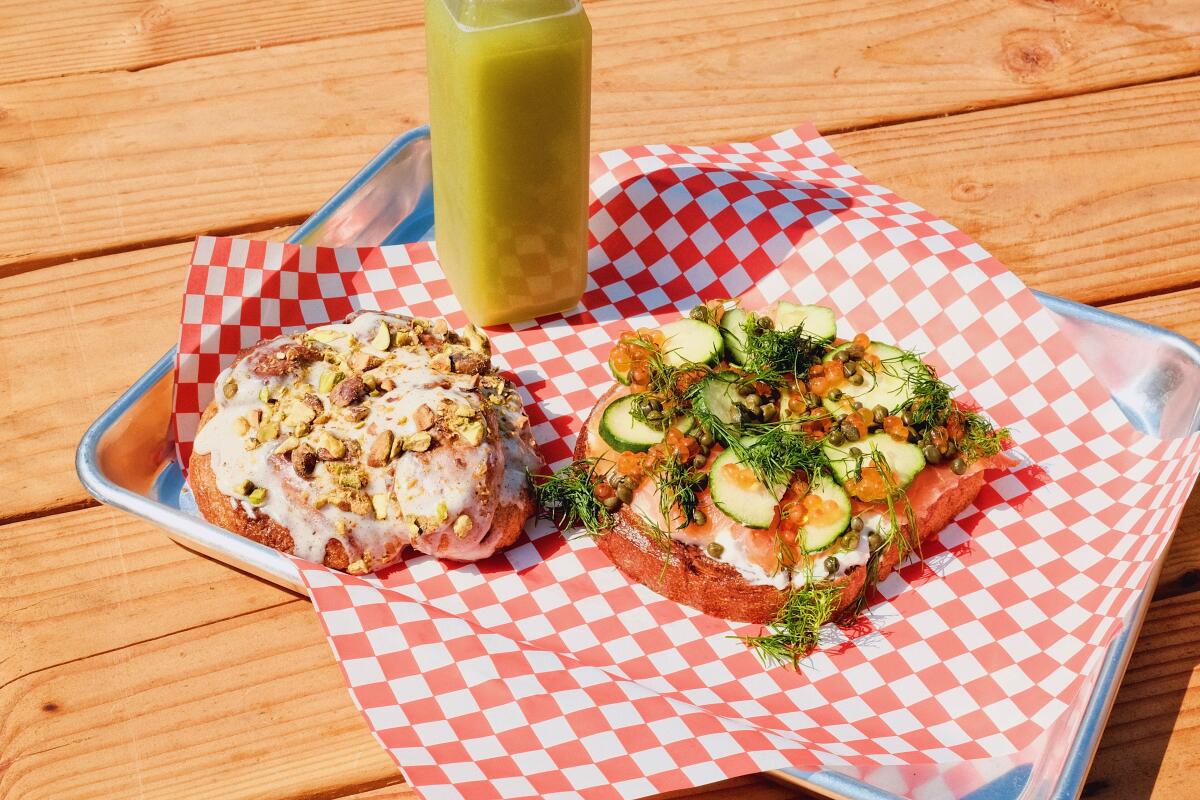
Piknik

There are gravlax smørrebrød, slabs of seasonal vegetable quiche, bottles of freshly squeezed juice and pistachio-topped cardamom buns along the edge of Echo Park Lake, next to the swan-boat rental dock. Restaurateur Don Andes and chef Dom Crisp have taken over the lake’s boathouse, and the duo behind nearby restaurant the Lonely Oyster have filled the 1932 building with cases of fruits and vegetables for fresh juice, plus a Scandinavian-inspired menu of smørrebrød, or open-faced sandwiches, which can come piled with smoked salmon, mushrooms, pickled herring, roast Wagyu or gouda. Piknik also serves salads, quiche, smoked-fish dip, meatballs, cookies and other pastries, ice cream and coffee. A handful of picnic tables along the lake, plus a long counter near the entrance, provide seats for Piknik, but the new cafe also sells picnic blankets for those who wish to take their meal elsewhere in the park. The team hopes to offer beer and wine in the future, and to serve multiple events held at Echo Park Lake such as Echo Park Rising and the Lotus Festival. Piknik is open daily from 8 a.m. to 11 p.m.
751 Echo Park Ave., Los Angeles, piknikla.com
Tartine
Some of L.A.’s best bread and pastries now can be found at the border of Santa Monica and Venice with a new location of Tartine. It marks the sixth currently operating L.A. location of Chad Robertson and Elisabeth Prueitt’s award-winning, Bay Area-founded bakery and cafe. The newest outpost, called Tartine Venice, serves the brand’s array of croissants, cakes, cookies and tarts along with whole and half loaves of fresh bread. There’s a full cafe menu of sandwiches, tartines, seasonal salads, omelets, quiches and a burger, as well as an espresso and tea menu. Tartine’s newest location is open daily from 7 a.m. to 4 p.m., and offers a large patio and free parking.
2903 Lincoln Blvd., Unit 110, Santa Monica, (424) 443-7727, tartinebakery.com
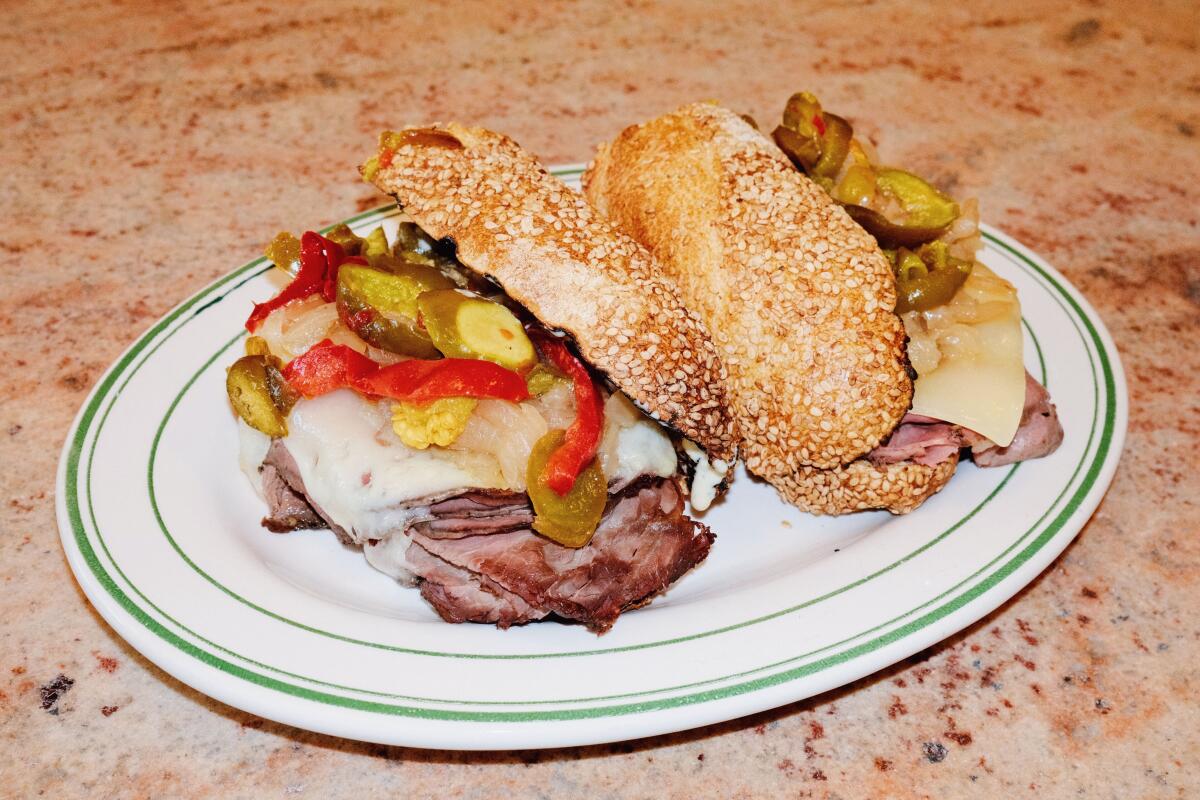
Ggiata Highland Park
Popular Italian sandwich shop Ggiata just debuted its fourth location, this time bringing its gooey parm sandwiches, classic deli-meat stacks, breakfast sandwiches, monthly specials and desserts like limoncello cake and rainbow cookies to Highland Park. Owners and childhood friends Noah Holton-Raphael, Max Bahramipour and Jack Biebel sought to bring a taste of New Jersey to Los Angeles in 2020, and have quickly expanded from Melrose Hill to West Hollywood and Venice in the years since. Their new 1,500-square-foot outpost in Northeast L.A. features Ggiata’s most seating yet, with booths and outdoor tables, plus a small low counter that overlooks the register for enjoying heaped sandwiches, salads and morning specialties. As is customary for Ggiata’s sandwich shops, a corner devoted to merch and limited-edition items — such as collaborations with streetwear brand Market or olive oil company Graza — can be found in Highland Park too. Ggiata is open in Highland Park from 9 a.m. to 8 p.m. Monday to Thursday and 9 a.m. to 9 p.m. Friday and Saturday.
5025 York Blvd., Los Angeles, ggiata.com
Taco Bell Cantina DTLA
Taco Bell remains a destination for many after a day or night of drinking, but the fast-food chain’s boozy offshoot, Taco Bell Cantina, offers a way to imbibe while eating its signature Crunchwraps, tacos, Mexican pizzas and burritos. L.A.’s second Taco Bell Cantina is now open, following the debut of the Hollywood outpost in 2023. While the Hollywood location is themed to Old Hollywood, with faux theater marquees and crystal chandeliers, the downtown Taco Bell Cantina riffs on rock ’n’ roll with guitars hanging on the walls and a louder, more colorful setting. When it comes to libations, Taco Bell Cantina’s signatures include “twisted” slushies, or “freezes,” which add rum, vodka or tequila to options such as Baja Blast, plus beer and wine. Taco Bell Cantina is open daily from 7 a.m. to 2 a.m. in the lobby; the window closes at 3 a.m.
801 7th St., Los Angeles, (626) 842-3006, tacobell.com
More to Read
Eat your way across L.A.
Get our weekly Tasting Notes newsletter for reviews, news and more.
You may occasionally receive promotional content from the Los Angeles Times.
